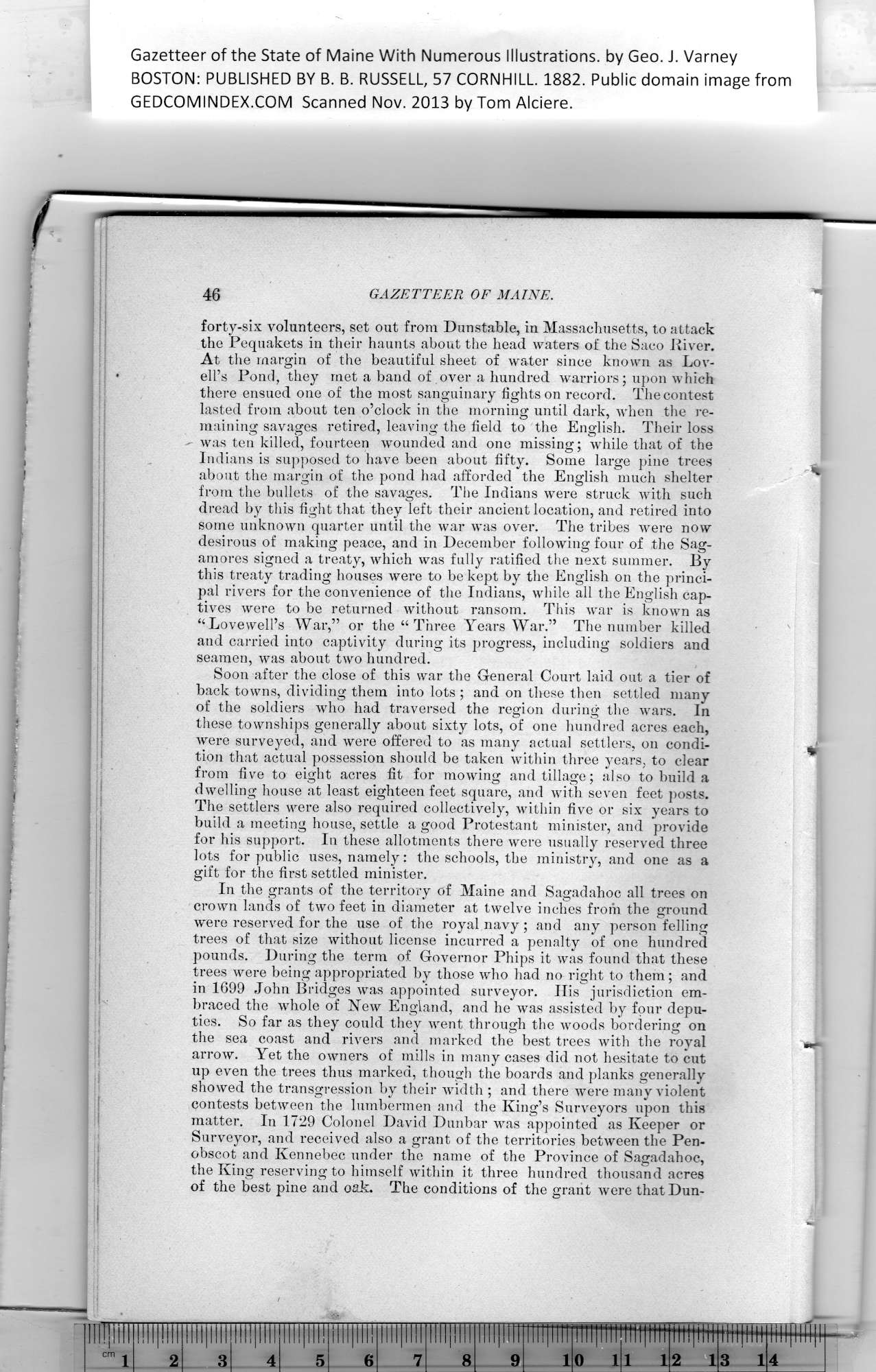|
Gazetteer of the State of Maine With Numerous Illustrations, by Geo. J. Varney
BOSTON: PUBLISHED BY B. B. RUSSELL, 57 CORNHILL. 1882. Public domain image from
46 GAZETTEER OF MAINE.
forty-six volunteers, set out from Dunstable, in Massachusetts, to attack
the Pequakets in their haunts about the head waters of the Saco River.
At the margin of the beautiful sheet of water since known as Lov-
ell’s Pond, they met a band of over a hundred warriors; upon which
there ensued one of the most sanguinary fights on record. The contest
lasted from about ten o’clock in the morning until dark, when the re-
maining savages retired, leaving the field to the English. Their loss
was tea killed, fourteen wounded and one missing; while that of the
Indians is supposed to have been about fifty. Some large pine trees
about the margin of the pond had afforded the English much shelter
from the bullets of the savages. The Indians were struck with such
dread by this fight that they left their ancient location, and retired into
some unknown quarter until the war was over. The tribes were now
desirous of making peace, and in December following four of the Sag-
amores signed a treaty, which was fully ratified the next summer. By
this treaty trading houses were to be kept by the English on the princi-
pal rivers for the convenience of the Indians, while all the English cap-
tives were to be returned without ransom. This war is known as
“Lovevvell’s War,” or the “ Three Years War.” The number killed
and carried into captivity during its progress, including soldiers and
seamen, was about two hundred.
Soon after the close of this war the General Court laid out a tier of
hack towns, dividing them into lots ; and on these then settled many
of the soldiers who had traversed the region during the wars. In
these townships generally about sixty lots, of one hundred acres each,
were surveyed, and were offered to as many actual settlers, on condi-
tion that actual possession should be taken within three years, to clear
from five to eight acres fit for mowing and tillage; also to build a
dwelling house at least eighteen feet square, and with seven feet posts.
The settlers were also required collectively, within five or six years to
build a meeting house, settle a good Protestant minister, and provide
for his support. In these allotments there were usually reserved three
lots for public uses, namely: the schools, the ministry, and one as a
gift for the first settled minister.
In the grants of the territory of Maine and Sagadahoc all trees on
ci’own lands of two feet in diameter at twelve inches from the ground
were reserved for the use of the royal navy ; and any person felling
trees of that size without license incurred a penalty of one hundred
pounds. During the term of Governor Phips it was found that these
trees were being appropriated by those who had no right to them; and
in 1699 John Bridges was appointed surveyor. His jurisdiction em-
braced the whole of New England, and he was assisted by four depu-
ties. So far as they could they went through the woods bordering on
the sea coast and rivers and marked the best trees with the royal
arrow. Yet the owners of mills in many cases did not hesitate to cut
up even the trees thus marked, though the boards and planks generally
showed the transgression by their width ; and there were many violent
contests between the lumbermen and the King’s Surveyors upon this
matter. In 1729 Colonel David Dunbar was appointed as Keeper or
Surveyor, and received also a grant of the territories between tbe Pen-
obscot and Kennebec under the name of the Province of Sagadahoc,
the King reserving to himself within it three hundred thousand acres
of the best pine and oak. The conditions of the grant tvere that Dun-
PREVIOUS PAGE ... NEXT PAGE
This page was written in HTML using a program written in Python 3.2
|
